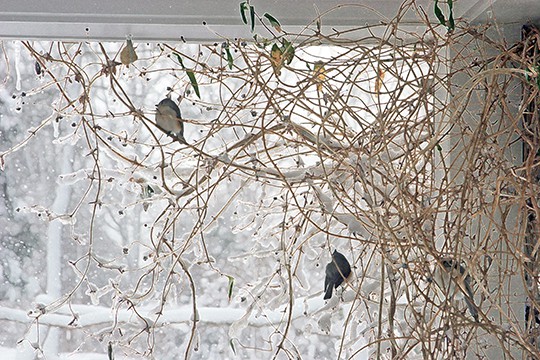A Gardening Life – February 14
During our last snow storm I discovered why a bit of neglect might be a good thing: I inadvertently created a place of protection for the birds. A refuge for wildlife in the winter? You can grow that!
During our last snow storm I discovered why a bit of neglect might be a good thing: I inadvertently created a place of protection for the birds. A refuge for wildlife in the winter? You can grow that!
I have a Belgica honeysuckle (Lonicera periclymenum ‘Belgica’) growing on the corner post of my front porch along with a ‘Colette’ climbing rose. When these are in flower their similar colors and sweet fragrances are delightful. After five years of minimal pruning, however, they have grown into a bit of a tangle.
That jumble of stems was on the leeward side of our house during the last storm, and the farmer’s porch offered some escape from the falling ice and snow. With hurricane force winds blowing for about twenty-four hours, it’s no wonder that the birds came to this spot to take shelter.
This spring I will give these plants a good trimming, but I’ll no longer think that they need tidying in the fall. I’m reminded that human standards of garden maintenance can be at odds with the needs of wildlife. We see leaf litter, while the butterflies see places where young caterpillars can overwinter. The tangle of vines that looks messy and “out of control” to us offers birds a place of protection in a storm.
Sometimes it takes a storm to open our eyes to a wider view.

The same birds didn't camp out here all day...there were many species who paused here to rest while Nemo's winds blew against the opposite side of the house.
Sharing The Wealth
- · If you don’t absolutely have to clear out excess growth in the fall, leave it in place over the winter.
- · Notice where winter winds often blow from and plant some shrubs on the leeward side of the house. The birds will find these places of shelter during storms.
- Be sure that your yard and garden contains a diversity of plants. A mix of evergreens and deciduous shrubs, and a combination of native and non-native plants for example. If there are edges and corners where you can leave some weeds and leaf litter, do so. It might appear wild and unkempt to you, but for birds and other critters it looks like home.

